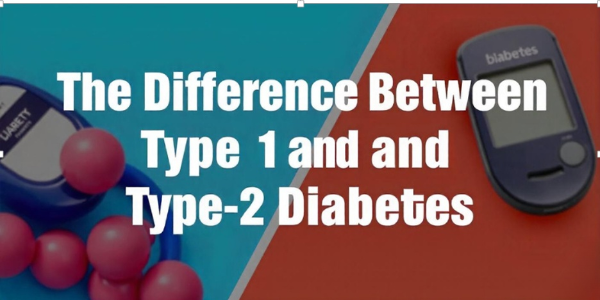Diabetes is a chronic condition that affects how the body regulates blood sugar, or glucose, which is crucial for providing energy to the body’s cells. When the body fails to produce or properly use insulin, the hormone responsible for helping glucose enter cells, blood sugar levels rise. There are two main types of diabetes: Type 1 and Type 2 Diabetes Mellitus. Although both forms of diabetes share some similarities, they are fundamentally different in their causes, symptoms, and treatment approaches. In this blog, we’ll explore what is Type 1 and Type 2 diabetes and highlight the key differences between them.
What Is Type 1 Diabetes?
Type 1 diabetes is an autoimmune condition, meaning the body’s immune system mistakenly attacks healthy cells. In this case, the immune system targets and destroys insulin-producing cells in the pancreas, leaving the body unable to produce insulin. Without insulin, glucose is unable to enter the cells, leading to elevated blood sugar levels.
This form of diabetes typically develops in childhood or adolescence but can also appear in adults. Type 1 diabetes is relatively rare, accounting for only 5–10% of all diabetes cases.
Causes of Type 1 Diabetes
The exact cause of Type 1 diabetes is still unknown, but it is believed to be a combination of genetic and environmental factors. Viral infections may play a role in triggering the autoimmune response that damages insulin-producing cells. Importantly, lifestyle factors, such as diet and exercise, do not cause Type 1 diabetes.
Symptoms of Type 1 Diabetes
Symptoms of Type 1 diabetes tend to develop quickly, often over the course of a few weeks. These symptoms include:
- Frequent urination
- Excessive thirst
- Extreme hunger
- Unintentional weight loss
- Fatigue and irritability
- Blurred vision
If you or a loved one experiences any of these symptoms, it’s essential to consult a diabetes specialist for diagnosis and treatment.
What Is Type 2 Diabetes?
Unlike Type 1 diabetes, Type 2 diabetes mellitus develops gradually over time and is often associated with lifestyle factors such as obesity and inactivity. In Type 2 diabetes, the body either produces insufficient insulin or becomes resistant to it, causing glucose to accumulate in the bloodstream and resulting in elevated blood sugar levels.
Type 2 diabetes is far more common than Type 1, accounting for approximately 90–95% of all diabetes cases. It typically affects adults over the age of 45 but can develop in younger individuals, especially those with risk factors such as obesity and a sedentary lifestyle.
Causes of Type 2 Diabetes
Several factors contribute to the development of Type 2 diabetes, including:
- Genetics: Having a family history of diabetes raises your risk.Lifestyle: Poor diet, lack of physical activity, and being overweight are significant contributors.
- Age: People over the age of 45 are at higher risk, although younger individuals can also develop the condition.
- Ethnicity: Certain ethnic groups, including African Americans, Hispanics, Native Americans, and Asian Americans, are more likely to develop Type 2 diabetes due to a combination of genetic and environmental factors.
Symptoms of Type 2 Diabetes
The symptoms of Type 2 diabetes may not appear for several years, making it difficult to detect in its early stages. Many people are unaware they have the condition until complications arise. Common symptoms include:
- Increased thirst and frequent urination
- Fatigue
- Blurred vision
- Slow-healing wounds
- Tingling or numbness in the hands and feet
If you are experiencing these symptoms or have risk factors, consult a diabetes specialist for screening.
Differences Between Type 1 and Type 2 Diabetes
While both types of diabetes affect the way the body regulates blood sugar, they differ significantly in terms of causes, onset, and treatment.
- Cause:
- Type 1 diabetes results from an autoimmune response that attacks and destroys the insulin-producing cells in the pancreas.
- Type 2 diabetes develops due to insulin resistance and insufficient insulin production, often linked to lifestyle factors like obesity and inactivity.
- Onset:
- Type 1 diabetes usually begins in childhood or adolescence, but it can occur at any age.
- Type 2 diabetes typically affects adults, especially those over 45, but is increasingly being diagnosed in younger individuals due to rising obesity rates.
- Symptoms:
- Type 1 diabetes symptoms appear suddenly and are more severe.
- Type 2 diabetes symptoms develop slowly over time and may go unnoticed for years.
- Treatment:
- Type 1 diabetes necessitates lifelong insulin therapy because the body is unable to produce insulin independently.
Type 2 diabetes can often be managed with lifestyle changes, including diet and exercise, but may also require oral medications or insulin injections in more advanced stages.
Managing and Treating Diabetes

Effective diabetes management is crucial to prevent complications such as heart disease, nerve damage, and kidney failure. For Type 1 diabetes, insulin injections or the use of an insulin pump are necessary to regulate blood sugar levels. Individuals with Type 1 diabetes must regularly monitor their blood sugar and adjust insulin doses as needed.
In contrast, Type 2 diabetes can often be managed through lifestyle changes, such as losing weight, eating a balanced diet, and increasing physical activity. For many people, these changes can help improve insulin sensitivity and lower blood sugar levels. However, if lifestyle changes are insufficient, medications like metformin or insulin injections may be prescribed.
Regardless of the type, regular blood sugar monitoring is essential. Your healthcare provider will guide you on how often to check your levels and adjust your treatment plan.
Can Diabetes Be Prevented?
While Type 1 diabetes cannot be prevented, certain lifestyle changes can help reduce the risk of developing Type 2 diabetes. Maintaining a healthy weight, eating a balanced diet, and staying physically active are key strategies for preventing Type 2 diabetes. Even small changes, such as exercising more and cutting back on processed foods, can make a big difference.
If you are at risk for Type 2 diabetes, it’s important to work closely with a diabetes specialist to monitor your blood sugar levels and take preventive measures.
Conclusion
Although Type 1 and Type 2 diabetes mellitus share the same name and some symptoms, they are different diseases with distinct causes and treatment approaches. Understanding the difference between Type 1 and Type 2 diabetes is essential for proper diagnosis and management. Whether you are dealing with Type 1 diabetes or Type 2 diabetes, working with a diabetes specialist is crucial to ensure effective management and improve your quality of life.







